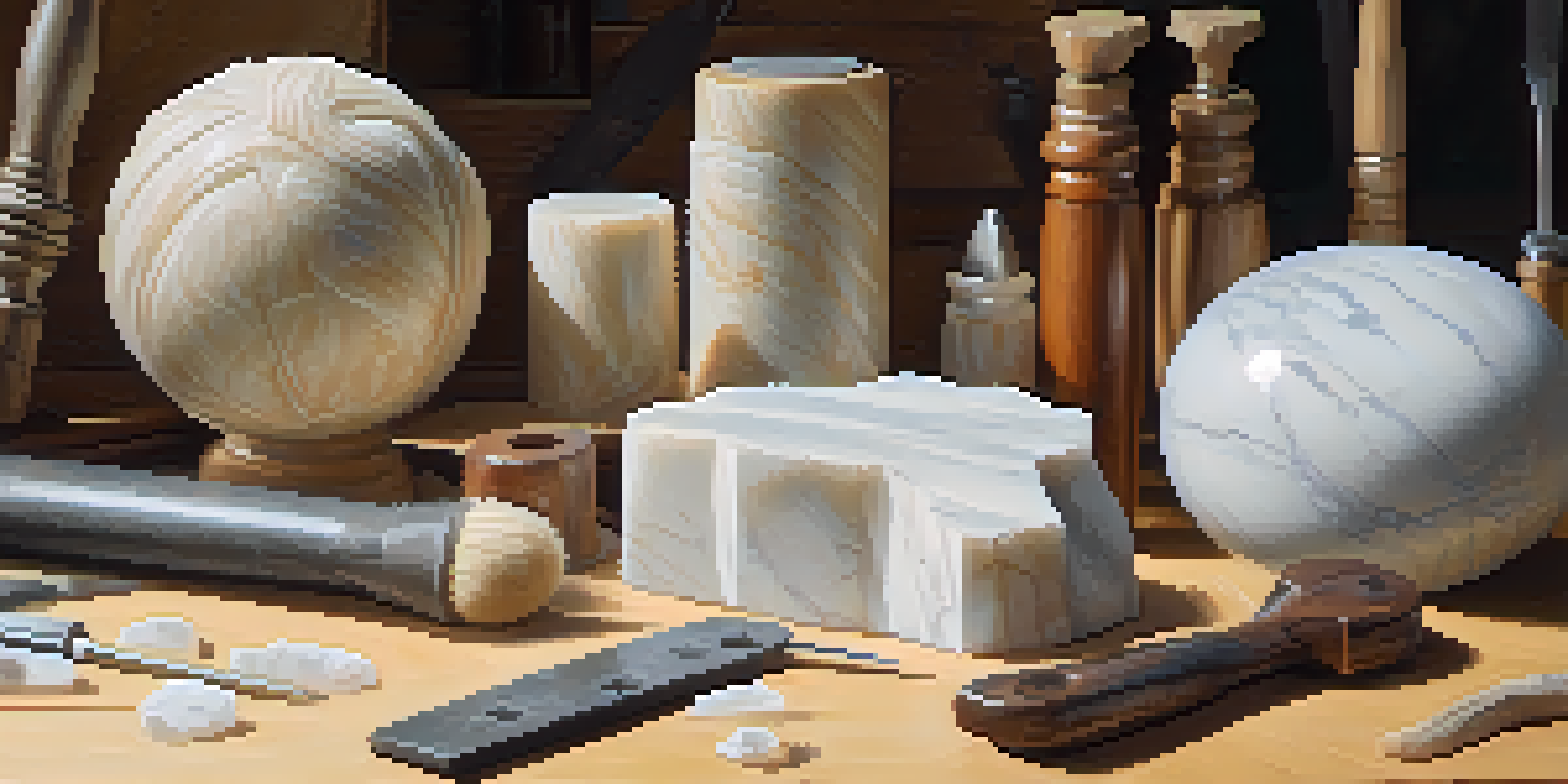Materials Used in Stone Carving: A Comprehensive Overview

Understanding the Basics of Stone Carving Materials
Stone carving is an ancient art form that requires a deep understanding of various materials. The choice of stone can greatly influence the final outcome, as each type has unique properties. Familiarizing oneself with these materials is crucial for both beginners and experienced carvers alike.
Every artist dips his brush in his own soul, and paints his own nature into his pictures.
In stone carving, durability, texture, and color are important factors to consider. For instance, softer stones like soapstone are easier to carve but may not hold fine details as well as harder stones. On the other hand, harder stones such as granite or marble can produce intricate designs but require more effort and specialized tools.
Ultimately, selecting the right stone is the first step toward creating a successful carving. Whether aiming for a rough-hewn look or a polished finish, understanding the characteristics of different stones can help artists make informed decisions.
Common Stones Used in Carving: An Overview
Among the most popular stones used in carving are marble, granite, limestone, and soapstone. Marble is prized for its beauty and translucence, often used in classical sculptures. Its fine grain allows for detailed work, making it a favorite among artists aiming for elegance.

Granite, while harder and more challenging to work with, is highly durable and often used for monuments and outdoor sculptures. Its wide range of colors and patterns can add a unique touch to any piece, showcasing the natural beauty of the stone.
Choosing the Right Stone Matters
The selection of stone significantly influences the carving's outcome, with each type offering unique characteristics that affect durability, texture, and detail.
Limestone is another commonly used stone that’s softer and easier to carve, making it ideal for beginners. It has a warm, earthy tone and readily accepts details, often used in architectural features and sculptures.
The Role of Soft Stones in Beginner Carving Projects
Soft stones like soapstone, alabaster, and calcite are excellent choices for beginners in stone carving. Their softness allows for easy manipulation, making the learning process more forgiving and less intimidating. This encourages creativity without the fear of making irreversible mistakes.
The sculptor brings the stone to life, revealing the beauty hidden within.
Soapstone, in particular, is favored for its smooth texture and variety of colors, ranging from greens to grays. Its gentle nature allows for both detailed and simple carvings, making it versatile for various artistic expressions.
As beginners gain confidence, they can experiment more with these soft stones, honing their skills before progressing to harder materials. This gradual approach helps build a solid foundation in the art of stone carving.
Hardstones: Challenges and Rewards in Carving
Carving harder stones like granite, basalt, and quartzite presents unique challenges, but the rewards can be significant. These stones are known for their toughness and durability, making them ideal for long-lasting sculptures and architectural elements. However, they require specialized tools and techniques for effective carving.
The process of carving hardstones can be labor-intensive and time-consuming. Artists often use diamond-tipped tools or pneumatic hammers to tackle the tough material. While this demands more effort, the results can yield stunningly detailed and resilient pieces.
Soft Stones for Beginners' Success
Soft stones like soapstone and alabaster are ideal for beginners, allowing for easier manipulation and fostering creativity without the fear of making irreversible mistakes.
Ultimately, working with hardstones can elevate a carver’s skill level. The patience and precision required push artists to refine their techniques, resulting in breathtaking works that stand the test of time.
Tools and Techniques for Stone Carving Mastery
Equally important as the stone itself are the tools used in the carving process. Essential tools include chisels, hammers, rasps, and saws, each serving a specific purpose in shaping the stone. Understanding how to use these tools effectively can significantly impact the quality of the finished piece.
For instance, point chisels are ideal for roughing out the shape, while flat chisels help create smoother surfaces. Rasps and files are used for refining details and achieving a polished finish. The right combination of tools can make the carving process more efficient and enjoyable.
As carvers gain experience, they often develop a preferred set of tools that best suits their style. Experimenting with different tools can lead to discovering unique techniques that enhance their artistic expression.
Preserving and Finishing Stone Carvings for Longevity
Once a stone carving is complete, preserving and finishing it is crucial for longevity. Various techniques, such as polishing, sealing, or applying wax, can protect the stone from environmental elements and enhance its appearance. Each method has its advantages, depending on the type of stone and the desired finish.
Polishing, for example, can bring out the natural luster in stones like marble and granite, while sealing helps safeguard them from moisture and stains. For softer stones, applying a wax finish can provide a protective layer that also enriches their color.
Tools Enhance Carving Quality
Using the right tools, such as chisels and rasps, is essential for effective stone carving, as they greatly impact the quality and efficiency of the finished piece.
Taking the time to properly finish and preserve a carving can greatly affect its lifespan and beauty. This final step is essential for ensuring that the artist's hard work is appreciated for years to come.
The Artistic Expression in Stone Carving Materials
Ultimately, the materials used in stone carving contribute significantly to the artistic expression of the piece. The choice of stone can reflect the artist's vision, style, and intention, influencing the viewer's experience. Each stone has its own story, and when transformed through carving, it becomes part of the artist's narrative.
Moreover, the natural variations in color and texture found in stones can inspire creativity and innovation. Artists often embrace the unique characteristics of each stone, allowing imperfections or natural patterns to guide their designs.

In this way, stone carving becomes not just a craft but a dialogue between the artist and the material. This relationship fosters a deeper understanding of both the stone and the creative process, resulting in truly unique works of art.